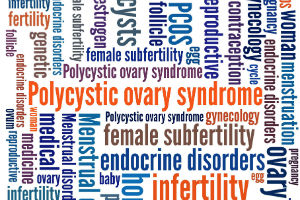Polycystic Ovary Syndrome – Symptoms, Impact, Early Diagnosis & Treatment
 The endocrine disorders among the females are of various types, but the most common one is the polycystic ovary syndrome (PCOS) which is considered to be an inherited disorder and can be received from either parent. The chances of the occurrence of this disease vary from 5-10% among females between the age group of 12-45 resulting in female –subfertility. The disorder is known by a number of other names like polycystic ovary disease, ovarian hyperthecosis, and stein-Leventhal syndrome. A polycystic ovary contains an abnormal number of eggs resembling as a cyst and can be viewed near its surface.
The endocrine disorders among the females are of various types, but the most common one is the polycystic ovary syndrome (PCOS) which is considered to be an inherited disorder and can be received from either parent. The chances of the occurrence of this disease vary from 5-10% among females between the age group of 12-45 resulting in female –subfertility. The disorder is known by a number of other names like polycystic ovary disease, ovarian hyperthecosis, and stein-Leventhal syndrome. A polycystic ovary contains an abnormal number of eggs resembling as a cyst and can be viewed near its surface.
Relation of cyclic changes and Polycystic Ovary Syndrome
The body of women repeatedly undergoes cyclic hormonal changes every month, and the cycle is more commonly known as Menstruation cycle. During this period, the ovary releases an egg and the oestrogen level increases. The lining of the womb thickens and prepares itself for the possibility of pregnancy. If the egg remains unfertilized, the lining of the womb sheds and exits the body through the vagina, mixes with the blood which is experienced by women as periods. Since the levels of hormones keep changing continuously, often it leads to an imbalance causing polycystic ovary syndrome or PCOS. PCOS can also be a hindrance to women’s ability to conceive.
Symptoms of Polycystic Ovary Syndrome
Understanding PCOS symptoms are extremely essential as it can occur at any time. The symptoms vary from woman to woman, below are some of the major symptoms:
- Abnormal Menstruation cycle: The hormonal changes associated with polycystic ovary syndrome can lead to unusual extended periods (up to a month or longer) or less than eight cycles per year or complete absence of menstruation for more than four months.
- Excessive Androgen Levels: Male hormones, collectively known as ándrogen’ are often the cause of physical signs such as an increase in the growth of facial hairs, severe acne, abnormal growth of hairs in the thighs or toes and male –pattern baldness in a woman suffering from PCOS.
- Infertility: Some women with PCOS often have difficulty in becoming pregnant due to painful intercourse and irregular or absence of ovulation. PCOS is the most prominent cause of infertility in women.
Obesity: Roughly 50% of women with PCOS are overweight.
- Diabetes: Women with PCSO are more likely to develop pre-diabetes or type 2 diabetes, often as a consequence of insulin resistance due to obesity.
- Acanthosis Nigricans- Some women with PSCO may develop dark, velvety skin on various parts of the body including neck, armpit, thigh, and breast.
- Mood swings: Women with PCOS also experience depression and frequent mood swings and breathing problems while sleeping.
Impact of Polycystic Ovary Syndrome
PCOS can cause some serious reproductive problems that result in difficulty in conceiving:
- Endometrial Hyperplasia: This condition arises when menstrual cycles are irregular. In the long run, it can lead to pre-cancerous or cancerous changes in the uterine lining.
- Increased Blood Pressure: PCOS leads to increase in the level of blood pressure during pregnancy or delivery and repaired miscarriages.
- Gestational Diabetes: The hormonal changes associated with Polycystic Ovary Syndrome can cause Gestational diabetes that involves high blood glucose levels during pregnancy. It is estimated fact delivered by the Centre for Disease and Control Prevention that over 9% of the pregnant women suffer from gestational diabetes.
- Vascular problems: The syndrome also causes heart and blood vessel problems including high cholesterol or high blood pressure, hardening of arteries or coronary artery disease can be a precursor for strokes and other cardiac problems.
- Infertility: It occurs when the egg is not released by the ovaries every month by the ovaries every month.
Early procedure of diagnosis
The procedure of diagnosis do not include only a single test; Doctors basically have to go through the medical history and physical examinations for the same that include:
- Check-up of the thyroid gland, belly, skin and breasts along with BMI value.
- A pelvic examination of the whole pelvic region helps the doctors to detect if a woman has abnormal or enlarged ovaries.
- Additionally, blood test can be done to find out Androgen and insulin levels, prolactin, cholesterol and triglycerides, glucose and thyroid- stimulating hormone(TSH), along with the levels of Follicle-stimulating Hormone(FSH) and Luteinising Hormone.(LH)
Treatment
- To keep the hormonal balance, doctors always recommend a healthy diet, abstinence from smoking, and regular exercise.
- Maintain a healthy lifestyle is paramount that includes eating of fruits, green vegetables, low-fat dairy products, etc. For example – If a woman is overweight, weight loss is helpful in regularizing the menstrual cycles and making a balance between the hormonal changes.
- Other options that help to deal with Polycystic syndrome includes insulin- sensitizing medications, topical anti-hair growth drugs and acne and hair loss treatments.
- Women who suffer from infertility from PCSO can opt for ovarian wedge resection or laparoscopic ovarian drilling, where a part of an ovary is removed to control hormonal levels and menstrual cycles.
To conclude, women suffering from Polycystic Ovary Syndrome must keep in mind that today’s medical science is technologically advanced and equipped. They should endeavour to remain stress-free and maintain a healthy lifestyle, properly should be in a coordination with their doctors by following the recommended treatment.
Ref Link:- http://mompluss.com/understanding-polycystic-ovary-syndrome?A=1












